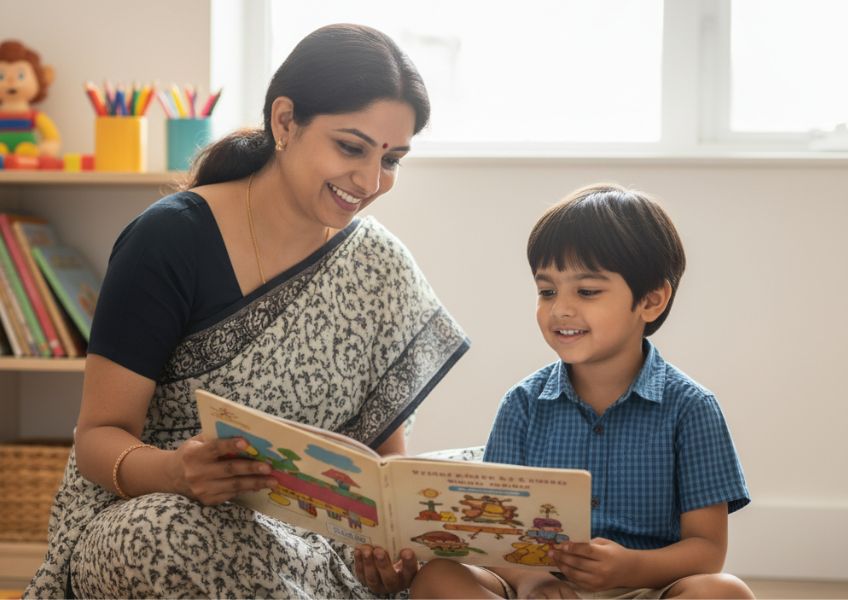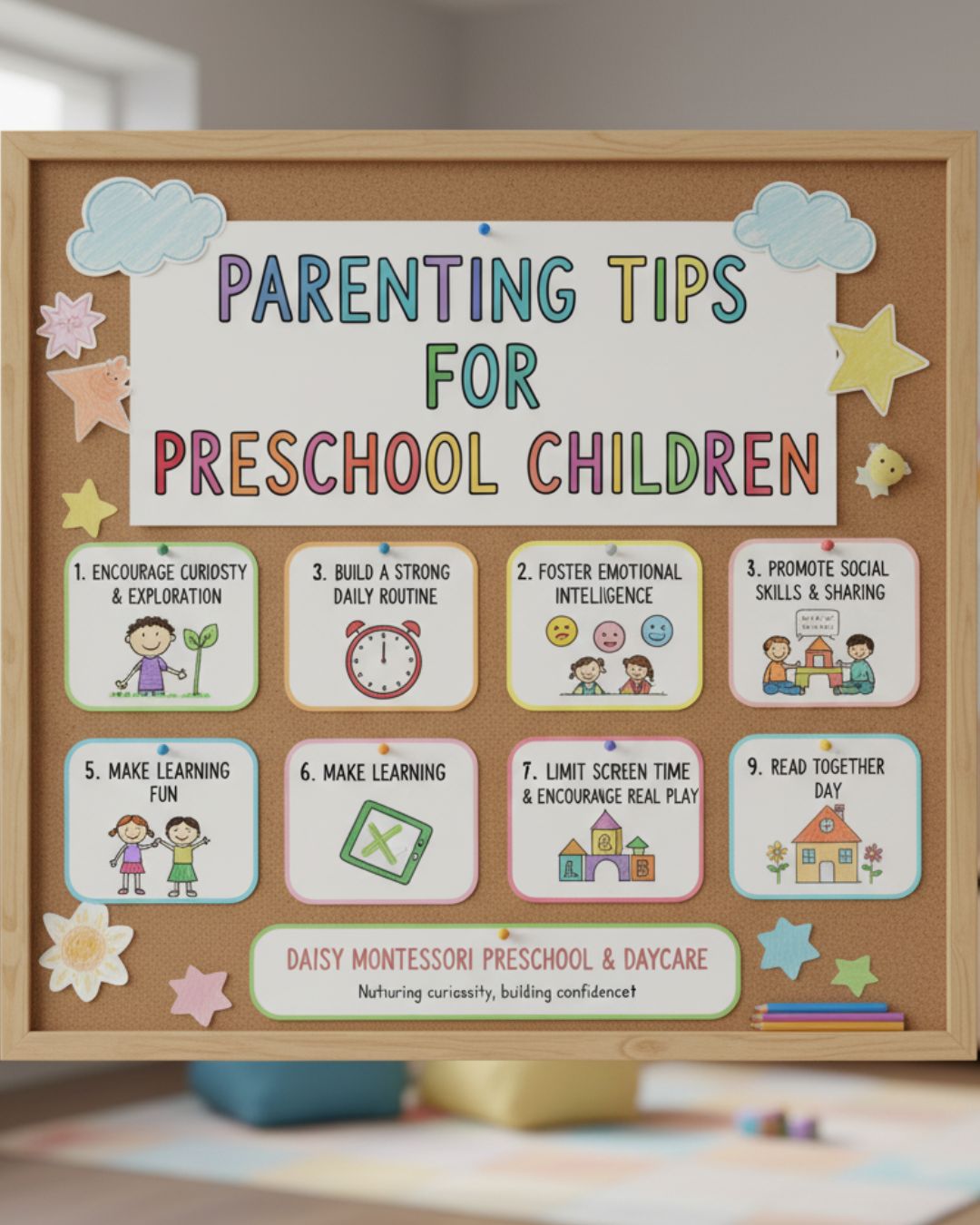When you think of storytelling in preschool, you might picture a group of bright-eyed children gathered around their teacher, listening intently as tales of adventure, animals, and imagination come to life. But storytelling is much more than an enjoyable pastime; it’s one of the most powerful tools in early childhood education. It nurtures language skills, sparks creativity, builds emotional intelligence, and lays the foundation for a lifelong love of learning.
At Daisy Montessori School, storytelling isn’t just an activity; it’s an integral part of our learning philosophy, one that encourages children to listen, imagine, express, and connect.
The Power of Stories in Early Learning
From fairy tales to fables, stories have been a part of human culture for centuries. They teach us lessons, connect us emotionally, and help us make sense of the world. For preschoolers, stories do even more they stimulate young minds, expand vocabulary, and strengthen listening skills.
When children listen to a story, they are not just hearing words; they are visualizing characters, predicting outcomes, and understanding emotions. This helps develop:
- Language comprehension and communication
- Attention span and concentration
- Empathy and emotional awareness
- Critical thinking and imagination
At Daisy Montessori School, storytelling sessions are designed to do exactly this spark curiosity and encourage self-expression through interactive learning experiences.
Why Storytelling Matters in Preschool Education
1. Boosts Language and Communication Skills
Preschoolers are in a phase of rapid language development. Listening to stories introduces them to new words, sentence structures, and expressions in a natural, engaging way. They learn how language works how to describe, question, and express ideas.
At Daisy Montessori, teachers encourage children to retell stories in their own words or act them out through role play. This not only improves verbal fluency but also builds confidence in speaking before others.
2. Encourages Imagination and Creativity
Every story opens a door to endless possibilities. Whether it’s a tale about a brave mouse or a magical forest, storytelling inspires children to think creatively. They begin to invent their own characters, endings, and adventures exercising their imagination in meaningful ways.
In a Montessori setting like Daisy Montessori School, creativity is celebrated. Teachers often use puppets, story cards, or dramatic play to help children bring stories to life. These experiences allow children to explore emotions, problem-solving, and collaboration.
3. Builds Emotional Intelligence
Stories often mirror real-life situations and feelings of friendship, kindness, courage, or even fear. As children relate to characters, they begin to understand emotions better. Discussing how a character felt or why they acted a certain way helps young learners develop empathy and compassion.
At Daisy Montessori, educators use storytelling to encourage open conversations about feelings, helping children recognize and express their emotions in healthy, positive ways.
4. Strengthens Memory and Concentration
Following a story from beginning to end helps children develop focus and recall skills. Remembering sequences of what happened first, next, and last strengthens cognitive development and comprehension.
Teachers at Daisy Montessori School often include storytelling games and memory-based activities that make learning fun while reinforcing attention and recall.
5. Instills Values and Life Lessons
Stories are powerful teachers of morals and values. Classic tales often revolve around honesty, kindness, patience, and respect lessons that shape a child’s character.
Through storytelling, Daisy Montessori helps children internalize these values naturally. Each story becomes an opportunity to discuss choices, consequences, and the importance of doing what’s right.
Storytelling the Montessori Way
In Montessori education, learning is holistic and child-centered. Storytelling aligns perfectly with this approach because it connects intellect with imagination and emotion.
At Daisy Montessori School, storytelling is woven into daily routines whether during circle time, language lessons, or even outdoor exploration. Teachers often allow children to choose stories, encouraging independence and decision-making.
Stories are not only told but also experienced through art, role-play, puppet theater, and music. This multisensory engagement helps children understand stories deeply and remember lessons longer.
Interactive Storytelling: Turning Listeners into Storytellers
One of the most effective storytelling methods at Daisy Montessori is interactive storytelling. Instead of simply listening, children become participants in the narrative. They might:
- Predict what happens next
- Imitate character voices or actions
- Draw scenes from the story
- Create alternative endings
This active involvement transforms passive listening into dynamic learning. Children not only absorb stories but also learn to think critically, communicate clearly, and express ideas creatively.
The Connection Between Storytelling and Reading
Storytelling lays the foundation for early literacy. Before children learn to read, they first learn to love stories. When a child enjoys listening to stories, they develop curiosity about words, letters, and books as the first steps toward reading readiness.
At Daisy Montessori School, teachers use storytelling as a bridge to reading. Children are introduced to picture books, rhymes, and phonetic sounds in a joyful and stress-free way. This helps them associate reading with pleasure, not pressure.

Storytelling Beyond the Classroom
The magic of storytelling doesn’t end at school it extends beautifully into homes. Daisy Montessori encourages parents to make storytelling a part of daily family life.
Even a few minutes of storytime before bed can:
- Strengthen the parent-child bond
- Improve listening and comprehension skills
- Build emotional security and imagination
When children see storytelling as a shared joy between home and school, it reinforces their sense of belonging and love for learning.
The Lasting Impact of Storytelling in Preschool
Long after children outgrow picture books, the lessons learned through storytelling stay with them. It shapes how they communicate, empathize, imagine, and understand the world.
By integrating storytelling into the curriculum, Daisy Montessori School helps children develop essential life skills from creative expression to emotional awareness and moral understanding. Each story told becomes a building block in their journey toward becoming thoughtful, confident, and compassionate individuals.
Conclusion: More Than Words, It’s a Way of Learning
In preschool, storytelling is far more than fun. It’s fundamental. It nurtures curiosity, communication, empathy, and imagination, the cornerstones of a well-rounded personality.
At Daisy Montessori School, stories are not just told; they’re lived, felt, and celebrated. Through the art of storytelling, children learn to see the beauty in words, the power of imagination, and the joy of discovery.
Because every great learner begins with a great story and at Daisy Montessori, every child’s story is worth telling.




